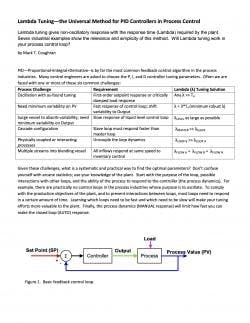Lambda Tuning -- the Universal Method for PID Controllers in Process Control
Given these challenges, what is a systematic and practical way to find the optimal parameters? Don't confuse yourself with arcane statistics; use your knowledge of the plant. Start with the purpose of the loop, possible interactions with other loops, and the ability of the process to respond to the controller (the process dynamics). For example, there are practically no control loops in the process industries whose purpose is to oscillate. To comply with the production objectives of the plant, and to prevent interactions between loops, most loops need to respond in a certain amount of time. Learning which loops need to be fast and which need to be slow will make your tuning efforts more valuable to the plant. Finally, the process dynamics (MANUAL response) will limit how fast you can make the closed loop (AUTO) response.



